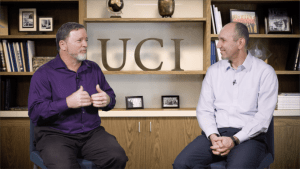Video Production Services
DTEI provides full video production services to support UCI faculty’s teaching needs from filming to post-production to online streaming to embedding interactive exercises within videos.
Video Types and Options

Placeholder
Green Screen Filming
Green screen filming applies the technique of chroma keying to remove the background (green) color from a video. This approach allows the video editor to insert additional objects (e.g., background images, icons, photos, and text) that align with the presenter’s speech during the post-production process.
The weatherman explaining the weather is a great example of the use of a green screen. The weather map behind the weatherman is inserted behind the presenter, which allows the weatherman to describe the weather conditions with a clear visual illustration.
A green screen studio is available at the Division of Teaching Excellence and Innovation (DTEI). Located in the Anteater Instructional and Research building, the green screen studio provides UCI faculty with more options and flexibility in creating instructional videos to motivate students’ learning interests.
If you would like to learn more about DTEI’s studio filming or post-production services, please contact us at DTEIsupport@uci.edu.
Video Samples
Tips and Best Practices
- Keep it short! – Online attention spans are much different than in the classroom. Try to “chunk” up your lecture into several smaller videos, each approximately 7-12 minutes in length.
- It’s okay to mess up! – You don’t have to be a one-take-wonder or do your entire lecture flawlessly—that’s what the editing team is for! If you flub or misspeak, just stop, take a breath, and restart from the beginning of that sentence or thought.
- Avoid wearing green or complicated patterns. – Green on clothes will be removed in post production along with the background, and intricate patterns can create an undesirable moire effect in the camera. Bold patterns are fine, and solid colors are best.

Placeholder
Learning Glass
Invented by Matt Anderson, a physics professor at San Diego State University, the learning glass equipment allows instructors to record a problem-solving demo or writing/drawing video while facing the viewers (students). It allows the writing action of a presenter to be captured in the instructional video, and the videographer can edit the video by adding additional video footage during the post-production process. Read our DTEI newsletter story to learn about how Dr. QV Dang from the Department of Electrical Engineering and Computer Science uses the Learning Glass to teach his computer programming course.
Tips and Best Practices
- Stick to one topic.
- Plan out your video ahead of time, so you know where to stand as you are drawing on the light board.
- Wear dark, solid-colored clothes, but avoid black.
- Don’t wear clothes that have text or logos. These will appear reversed in the video.
- Small mistakes that can be quickly erased are okay.

Placeholder
Interviews & Guest Speakers
If you would like to include a guest speaker interview video in your online course, it can be recorded in our video production studio. Three video cameras will be used to capture multiple people having a discussion synchronously. If you would like to get more information about creating an interview and/or guest speaker videos, please contact us at DTEIsupport@uci.edu.
Video Samples
Tips and Best Practices
- Reserve the video studio with DTEI’s videographer as early as possible
- Prepare your guest speakers by letting them know the purpose of the video and what kind of “take away” you’d like the viewer to receive after watching the video
- Outline some talking points or questions for the guest speakers before filming
